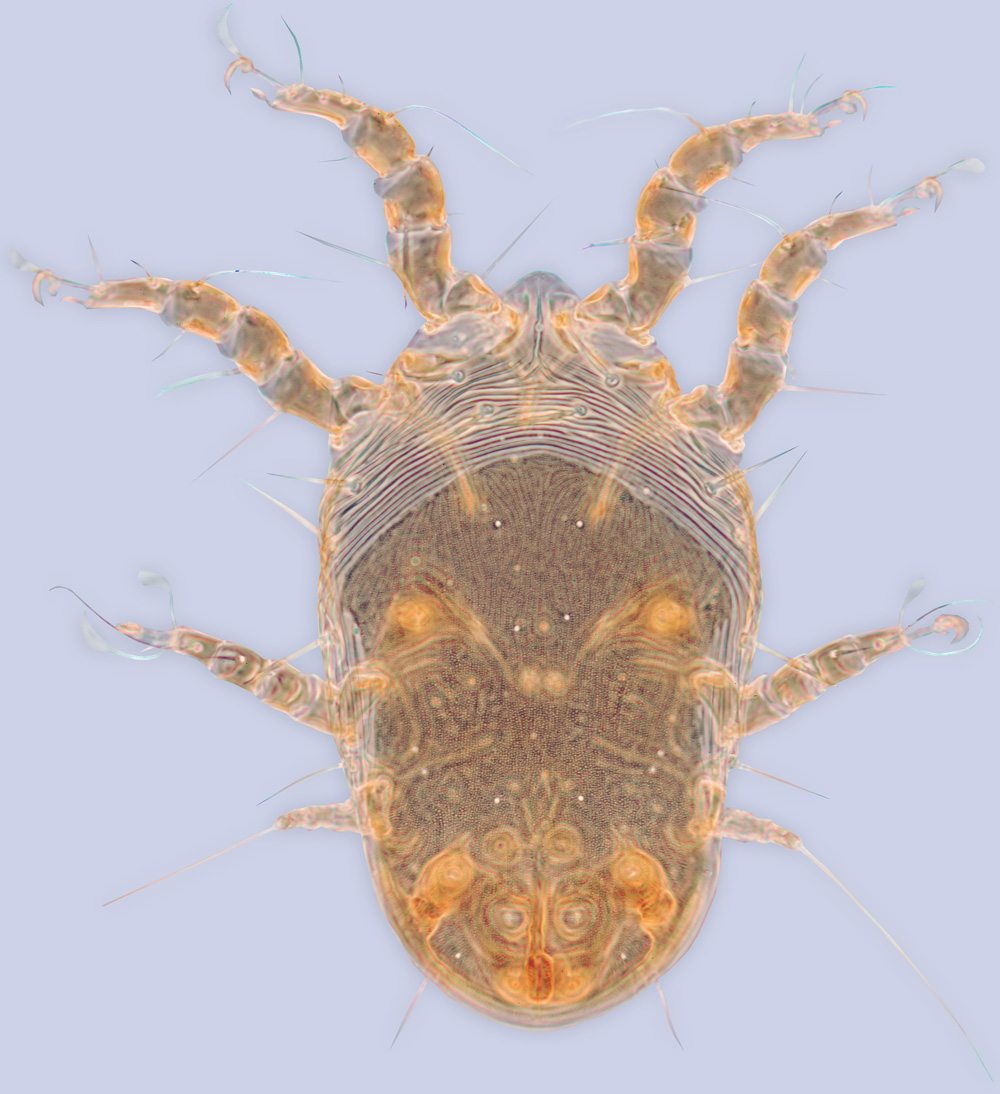Bee Mites : Acari : Acariformes : Sarcoptiformes : Chaetodactylidae : Sennertia : Sennertia species
Sennertia haustrifera Klimov and OConnor, 2008
Sennertia haustrifera Klimov and OConnor, 2008: 151, Figs 72-73.
Material (show database records). (MEXICO). Holotype: HDN - Jalisco, Estación de Biología Chamela, UNAM, 19°32'N 105°05'W, 8 Sep 1983, S.H. Bullock, ex Ceratina capitosa, LACM BMOC 97-0331-035. Paratypes: 9 HDNs - same data as holotype; 6 HDNs - same data, 18 Apr 1980, BMOC 97-0331-036; 5 HDNs - same data, BMOC 97-0331-039; 6 HDNs - same data, 31 May 1983, BMOC 97-0331-037; 10 HDNs - same data, 31 Aug 1982, BMOC 97-0331-034; 2 HDNs - Chiapas, 20 km N Acala on road along Rio Grijalva, 548 m., 30 Jul 1981, D. E. & P. M. Breedlove, ex Ceratina sp. (propodeum), CAS BMOC 03-0604-019. Holotype in LACM, paratypes in CAS, LACM, UMMZ, UNAM.
Description. Phoretic deutonymph. Gnathosomal solenidia shorter than 1/3 of femur I width. Supracoxal setae scx situated on dorsal extension of posterior apodeme I. Hysterosomal shield distinctly expanded beyond lateral gland opening and bases of setae f2. Lateral edges of hysterosomal shield in anterior part not narrowing. Dorsal hysterosomal pouch absent. Distance between anterior margin of hysterosomal shield and setae si exceeds diameter of si bases. Striate pattern of idiosomal cuticle outside hysterosomal shield formed by long striae, with sclerotization, sclerotization shifted to posterior striae. Distinct rudiments of vi absent. Setae si distinctly posterior se, exceed 1/2 of se, almost as thick as se. Diameter of si exceeds 1/2 of diameter of se. Setae c1 and d1-h1 uniform in length, microsetae. Setae c1 microsetae; situated posterior to anterior margin of hysterosomal shield. Setae c3 conoidal, situated on large triangle sclerite touching posterior apodemes II and anterior apodemes III. Setae d1 and e1 nearly uniform in length with h1. Setae d1 situated on hysterosomal shield. Sclerite between ia and d2 absent. Setae e2 subequal with d2, not touching hysterosomal shield. Lateral gland openings situated on hysterosomal shield. Setae 4b conoidal. Setae 4b, g, and 4a without distinct rhomb-like widening (4b pear-shaped, 4a and g filiform). Setae pR I-II, sR III, wF IV, gT I-II, hT I-II, kT III, ra I-II, and wa I-II filiform. Posterior apodemes II and anterior apodemes III free. Anterior apodemes IV not interrupted, almost straight. Posterior apodeme IV present, connected to anterior apodeme III. Conoids ps2 anterior to anterior transverse level of central suckers (ad1+2); anterior to ps1, situated outside outer level of ad1+2. Transparent margin of anterior suckers (ad3) with rough sclerotization, maximal length of rough sclerotization distinctly shorter than two diameters of anterior suckers. Suckers ad3 not enlarged, smaller than central suckers. Posterior and lateral borders of attachment organ not forming distinct frame. Sclerotized rudiment of anterior cuticular suckers absent. Longitudinal hysterosomal sclerite present, long. Ventral hysterosoma smooth. Genual setae mG I-II bifid at tips, mG II shorter than femur II. Tarsal setae la I-II longer than famulus ε. Tarsal setae ra I-II not bifid, filiform. Tarsal setae wa I-II and s III filiform, needle-like, or widened basally but with attenuated end. Tarsal setae d I-II foliate. Tarsal setae d and f I-II almost symmetrical, d and f I not touching. Solenidion ω3 closer to f I than to ω1. Posterior condylophore present. Anterior condylophore I-II with distal bending. Seta d III situated shifted from tarsal base, distance distinctly exceeding diameter of d III alveolus. Leg IV not protruding posterior edge of hysterosoma. Tarsus IV not enlarged, shorter or less than 2 times longer than width of trochanter IV. Setae w IV thinner than d IV and distinctly shorter than leg IV, situated on middle of tarsus IV. Setae s IV present. Setae wF IV not protruding tibia IV.
Other instars unknown.
Hosts. Ceratina capitosa Smith, 1879 (Apidae).
Distribution (Show map). Mexico: Jalisco (type locality), Chiapas.
Etymology. The specific epithet is formed from the Latin noun haustrum (=pump) and the verb fero (=to carry, bear), considered as an adjective.
References
Klimov, P. B. & B. M. OConnor. 2008. Morphology, evolution, and host associations of bee-associated mites of the family Chaetodactylidae (Acari: Astigmata), with a monographic revision of North American taxa. Miscellaneous Publications Museum of Zoology University of Michigan.199: 1-243.
B. OConnor and P. Klimov ©
Created: May 26, 2011
Last modified: 
